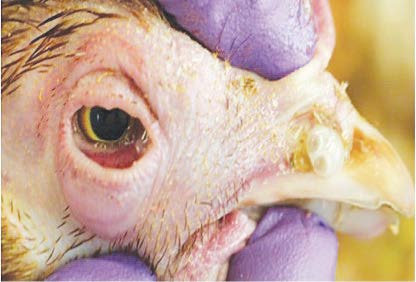
AFTER successfully raising a healthy flock, farmers may encounter challenges with diseases, which may result in the rise in mortality and adversely affect the profitability of the enterprise.
Today we focus on three diseases – bird flu/avian influenza, infectious coryza and infectious bronchitis and possible mitigation measures.
Bird Flu/Avian Influenza
Bird flu, also known as avian influenza, is a type A influenza virus. This virus is dangerous to poultry and is potentially fatal to humans. Bird flu spreads between wild and domesticated birds. It has also been passed from birds to farmers and farm workers who are in close contact with poultry or other birds.
How it is spread
Birds such as wild ducks and storks are believed to be the carriers of all avian influenza type A viruses inside their intestines and are distributed into the environment through droppings. Migratory birds with the virus can potentially spread it to any of the countries they visit.
A sick bird sheds the virus in its feathers, mucous, saliva and droppings. On the other hand, humans who have close contact with sick birds are at risk of infection. For example, a person may handle a sick bird, contaminate their hands with droppings, and forget to wash their hands before eating. They will then ingest the infected droppings. The virus can also survive in raw poultry meat but is destroyed during normal cooking.
Symptoms
Symptoms differ according to the bird species but can include; diarrhoea, breathing difficulties, swollen heads, discolouration of combs and wattles, coughing and sneezing, loss of appetite, depression, layers suddenly stop laying.
Sometimes sudden death may also occur without any previous signs.
There is no evidence that the current circulating H5N1 strain of bird flu can be spread easily from human to human. The incubation periods for these viruses range from as short as a few hours to three days in individual birds and up to 14 days to spread through a flock.
Spreading of AI viruses from farm to farm is mainly by mechanical transfer of infective droppings in which the virus may be present. Shared water or food may also become contaminated.
Caretakers, farmers, workers, trucks and drivers visiting farms, moving birds or delivering food have spread the AI virus on to and within farms.
Infectious Choryza
Infectious coryza is a severe respiratory chicken disease whose symptoms are characterised by decreased activity, nasal discharge, sneezing and facial swelling.
The disease only affects chickens such as pullets, layers and occasionally broilers. Compromised or poor biosecurity practices and environmental factors also contribute to the spread of the disease.
On farms, infected flocks are a constant threat to uninfected flocks. Transmission is usually through direct contact, airborne droplets and contaminated water.
However, is it important to note that infectious coryza is not transmitted through eggs?
Most farms have adopted an all-in and all-out management practice to eradicate the disease. All in and all out programmes are designed to move all animals of the same age at the same time allowing fowl runs to be disinfected before the next group is introduced.
Treatment
Farmers can use antibiotics to control secondary infections but vaccination from the onset is best at all times.
Infectious bronchitis
Infectious bronchitis (IB) is a highly contagious, viral respiratory disease, characterised by coughing and sneezing. The disease affects the kidneys, decreases egg production and impairs the quality of eggs produced. The infectious bronchitis virus is spread by infected chickens through respiratory discharges and droppings. The disease is spread through ingestion of contaminated feed and water, and contact with contaminated equipment and clothing.
Signs of infection
Coughing, sneezing, snoring sounds for 10–14 days, facial swelling, depression, decrease in feed consumption and weight gain, ruffled feathers and wet droppings.
Egg production may drop by as much as 70%, and eggs are often misshapen, with thin, soft, wrinkled, rough, and/or pale shells, and can be smaller and have watery albumen. Egg production and egg quality can return to normal, but this may take up to eight weeks. In most outbreaks, mortality is approximately 5%, although mortality rates can be as high as 60% when the disease is complicated by concurrent bacterial infection.
Control
The most effective route to control infectious coryza is by vaccination.
Chicken diseases account for nearly 90% of mortalities on farms which directly affect the farmer’s productivity and profitability. To control the spread of diseases, farmers are advised to introduce strict biosecurity systems and stick to them







